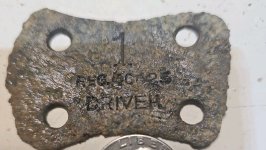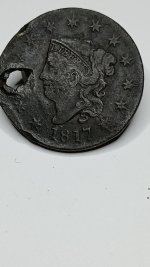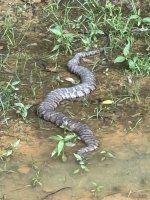joshuadl
Tenderfoot
I think the most likely explanation is milling balls.
These two spheres were found in some freshly turned soil in Rural Oklahoma. At first observation they appear to be some kind of highly polished and handmade stone ball or marble. The objects have similar coloring and pitting that a stone would. They feel like polished stone and sound like stone when clicked together. They look how I thought a sphere would look if someone tried to make it by hand. The larger one is almost egg shaped as is the smaller one to a slightly lesser extent.
I have seen similiar objects posted on forums and some of the posters identified them as milling balls even if the OP said he/she had taken the ball to an expert and been told they were something else. I am perfectly accepting of this identification but there are some factors that I think should be considered for a final conclusion. After examining the thing I am fairly certain it isnt Native American, but I would really like to know exactly what they are. The details of my examination are below..
Found in some freshly turned soil from a dirt road that was recently cut through some rural pastureland. If it is a milling ball I dont know how it could have gotten here. Similar to a lot of the other posts regarding spheres like this, it was found in an area that is nowhere near any kind of industrial facility so I dont think it was used in a ball mill near this area. However it could have been dumped here as garbage by a company at some point in the past.. Although I doubt anytime recently because the land has been used as pasture land for a while and there are no indications that an industrial facility was located here. Anyone know when the manufacture of ceramic milling balls began? It is possible they come from a nearby drilling rig. They could have been stuck in some parts that were shipped from a factory that went through some kind of deburring process. Maybe drilling rigs have some sort of ball mill on site to debur equipment. Although a family member who works in the industry did not know what they were.
Initially the spheres look like how I would expect a polished white stone to look.. It is a matte white color with some red splotching that looks to me like it could be natural graining. However the red color could be from sitting for a long time in the red Oklahoma clay. Its important to note that there are also some speckles look surprising similar to those found on some bird's eggs. The photographs make the objects appear more plastic like than they look in real life
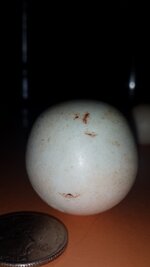
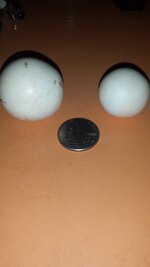
The texture of the ball is extremely smooth except where there is scarring and indentations. It is possible for a stone to be smoothed this way but it seems unlikely to me that a primitive man could do such a thorough job. I cant see any kind of chip marks where it was shaped, but I am not an expert on stone work and do not know all the methods can be used to smooth a stone or shape into a sphere by hand. This was the first thing that made me doubt that it was a Native American artifact.
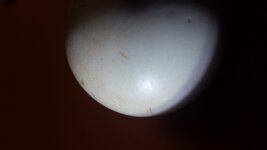
The objects feel like polished stone the weight seems about right for it to be a stone of lighter material as well. The spheres always feel a lot colder to the touch then a think they should when I pick them up. Its always surprising how cold they are when I initially touch them.
As stated, the objects are sphere like and at first looked to me like how a stone would be shaped if it was made into a sphere by hand. Almost if it they had been clay and balled in someones palm but they exhibit no other properties of clay or pottery. The objects seem to be perfectly rounded at what I am calling the top and bottom and they seem to slope uniformly along the entire circumference from the larger 'bottom' to the smaller 'top'. This is done in such a way that I think it could have been intentionally designed in this way. When I learned of the milling balls I thought this could be attributed to natural wear from the ball mill until I saw how the thing operated. I do not believe that if it is in fact wearing, that it could have occurred in a tumbler because of the uniformity around the surface. If the spheres were some type of bearing, then I think it is feasible that wearing of this type could occur. But only if the bearing rotated on a single axis. The larger ball is weighted in a way that makes it rock back and forth as if it was attached to magnetic surface. Very odd if it was natural wear from a manufactured sphere, but not impossible.
(I have a video if anyone wants to see it)
Now on to the testing:
After searching the internet for a while and determining that I probably wouldnt be defacing a historically significant object I decided to do some unscientific analysis on it to try and find out what it was made of. I decided to experiment on the smaller of the two
The first thing I did was clean it with soap and water to see if the red would come off which I thought may happen if it was staining from the dirt. (photos are from after the washing). The red did not disappear after cleaning.
To see if it was some kind of glazed pottery I decided to try and cut into it with an extremely sharp serrated blade. This is where things got interesting. The blade left a thin grey line, like a pencil mark. It even looked like graphite. I couldnt see a scratch in the material so I thought maybe somehow the material was super hard and the black came from the metal of the knife. Next I tried a file from a Gerber tool and it also just made a graphite/lead looking smudge on the exterior. I still could see any kind of scracthing in the surface of the object, but the black smudge..smudged. It even got on my fingers and spread over the top of the white outer layer and allowed me to leave fingerprints on paper. It certainly didnt seam heavy enough to be lead and was nowhere near as soft as lead. I used a small metal saw and could only scratch the white stuff on the outside which I know believe to be some sort of paint-like coating. This discovery leads me to believe that the shape of the objects could not be from wearing. If the objects had been worn down into the shape they are then the coating would have come off first. The coating had to have been applied after the objects were in their current shape.
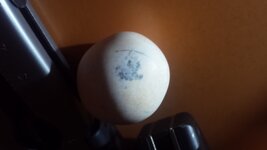
Obviously the next logical thing to do was hold a cigarette lighter to it and see how the coating and material underneath reacted. I held a butane barbecue lighter to the object for about 20 seconds. The coating appeared to sweat and I thought it was melting off but when I immediately wiped it with a napkin the coating was unaffected. Also the object had barely any change in temperature. Next I tried 30 seconds before the fuel ran out of the lighter. Same results . I think the sweating is probably some kind of byproduct left by the butane burning.
Next I tried a magnet and as expected it had no effect.
In conclusion I still do not know what these things are
They appear to be some type of metal or stone with a coating on them. The coating appears to be paint but is very smooth and with a perfectly uniform application. The coating is resistant to heat and heat doesn't transfer well through the metal/stone material.
Maybe it is a type of black ceramic mixture that has a coating over it, but it would have to have been intentionally made in this shape or the thin coating would have worn off. Additionally, the ring left over from the mold that I have seen to be a tell-tell sign of milling balls is absent, as is any other marking from a mold. If I thought the object had been worn down I wouldnt consider this curious, however as stated above I do not believe the object to have been worn down.
Any ideas what material this could be?
My top theories of what they are:
Milling balls for homemade gunpowder.
Some sort of weight
Fake eggs for chicken coop or decoration
Childs toy or game pieces
These two spheres were found in some freshly turned soil in Rural Oklahoma. At first observation they appear to be some kind of highly polished and handmade stone ball or marble. The objects have similar coloring and pitting that a stone would. They feel like polished stone and sound like stone when clicked together. They look how I thought a sphere would look if someone tried to make it by hand. The larger one is almost egg shaped as is the smaller one to a slightly lesser extent.
I have seen similiar objects posted on forums and some of the posters identified them as milling balls even if the OP said he/she had taken the ball to an expert and been told they were something else. I am perfectly accepting of this identification but there are some factors that I think should be considered for a final conclusion. After examining the thing I am fairly certain it isnt Native American, but I would really like to know exactly what they are. The details of my examination are below..
Found in some freshly turned soil from a dirt road that was recently cut through some rural pastureland. If it is a milling ball I dont know how it could have gotten here. Similar to a lot of the other posts regarding spheres like this, it was found in an area that is nowhere near any kind of industrial facility so I dont think it was used in a ball mill near this area. However it could have been dumped here as garbage by a company at some point in the past.. Although I doubt anytime recently because the land has been used as pasture land for a while and there are no indications that an industrial facility was located here. Anyone know when the manufacture of ceramic milling balls began? It is possible they come from a nearby drilling rig. They could have been stuck in some parts that were shipped from a factory that went through some kind of deburring process. Maybe drilling rigs have some sort of ball mill on site to debur equipment. Although a family member who works in the industry did not know what they were.
Initially the spheres look like how I would expect a polished white stone to look.. It is a matte white color with some red splotching that looks to me like it could be natural graining. However the red color could be from sitting for a long time in the red Oklahoma clay. Its important to note that there are also some speckles look surprising similar to those found on some bird's eggs. The photographs make the objects appear more plastic like than they look in real life


The texture of the ball is extremely smooth except where there is scarring and indentations. It is possible for a stone to be smoothed this way but it seems unlikely to me that a primitive man could do such a thorough job. I cant see any kind of chip marks where it was shaped, but I am not an expert on stone work and do not know all the methods can be used to smooth a stone or shape into a sphere by hand. This was the first thing that made me doubt that it was a Native American artifact.

The objects feel like polished stone the weight seems about right for it to be a stone of lighter material as well. The spheres always feel a lot colder to the touch then a think they should when I pick them up. Its always surprising how cold they are when I initially touch them.
As stated, the objects are sphere like and at first looked to me like how a stone would be shaped if it was made into a sphere by hand. Almost if it they had been clay and balled in someones palm but they exhibit no other properties of clay or pottery. The objects seem to be perfectly rounded at what I am calling the top and bottom and they seem to slope uniformly along the entire circumference from the larger 'bottom' to the smaller 'top'. This is done in such a way that I think it could have been intentionally designed in this way. When I learned of the milling balls I thought this could be attributed to natural wear from the ball mill until I saw how the thing operated. I do not believe that if it is in fact wearing, that it could have occurred in a tumbler because of the uniformity around the surface. If the spheres were some type of bearing, then I think it is feasible that wearing of this type could occur. But only if the bearing rotated on a single axis. The larger ball is weighted in a way that makes it rock back and forth as if it was attached to magnetic surface. Very odd if it was natural wear from a manufactured sphere, but not impossible.
(I have a video if anyone wants to see it)
Now on to the testing:
After searching the internet for a while and determining that I probably wouldnt be defacing a historically significant object I decided to do some unscientific analysis on it to try and find out what it was made of. I decided to experiment on the smaller of the two
The first thing I did was clean it with soap and water to see if the red would come off which I thought may happen if it was staining from the dirt. (photos are from after the washing). The red did not disappear after cleaning.
To see if it was some kind of glazed pottery I decided to try and cut into it with an extremely sharp serrated blade. This is where things got interesting. The blade left a thin grey line, like a pencil mark. It even looked like graphite. I couldnt see a scratch in the material so I thought maybe somehow the material was super hard and the black came from the metal of the knife. Next I tried a file from a Gerber tool and it also just made a graphite/lead looking smudge on the exterior. I still could see any kind of scracthing in the surface of the object, but the black smudge..smudged. It even got on my fingers and spread over the top of the white outer layer and allowed me to leave fingerprints on paper. It certainly didnt seam heavy enough to be lead and was nowhere near as soft as lead. I used a small metal saw and could only scratch the white stuff on the outside which I know believe to be some sort of paint-like coating. This discovery leads me to believe that the shape of the objects could not be from wearing. If the objects had been worn down into the shape they are then the coating would have come off first. The coating had to have been applied after the objects were in their current shape.

Obviously the next logical thing to do was hold a cigarette lighter to it and see how the coating and material underneath reacted. I held a butane barbecue lighter to the object for about 20 seconds. The coating appeared to sweat and I thought it was melting off but when I immediately wiped it with a napkin the coating was unaffected. Also the object had barely any change in temperature. Next I tried 30 seconds before the fuel ran out of the lighter. Same results . I think the sweating is probably some kind of byproduct left by the butane burning.
Next I tried a magnet and as expected it had no effect.
In conclusion I still do not know what these things are
They appear to be some type of metal or stone with a coating on them. The coating appears to be paint but is very smooth and with a perfectly uniform application. The coating is resistant to heat and heat doesn't transfer well through the metal/stone material.
Maybe it is a type of black ceramic mixture that has a coating over it, but it would have to have been intentionally made in this shape or the thin coating would have worn off. Additionally, the ring left over from the mold that I have seen to be a tell-tell sign of milling balls is absent, as is any other marking from a mold. If I thought the object had been worn down I wouldnt consider this curious, however as stated above I do not believe the object to have been worn down.
Any ideas what material this could be?
My top theories of what they are:
Milling balls for homemade gunpowder.
Some sort of weight
Fake eggs for chicken coop or decoration
Childs toy or game pieces
Last edited:
Upvote
0



